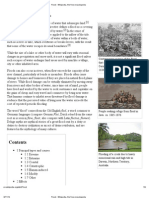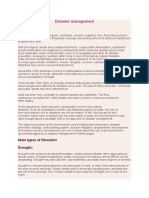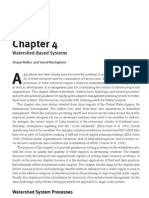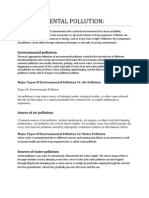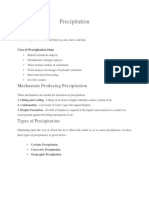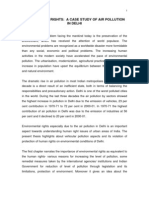Principal Types and Causes: Areal
Principal Types and Causes: Areal
Uploaded by
Gopala Krushna NayakCopyright:
Available Formats
Principal Types and Causes: Areal
Principal Types and Causes: Areal
Uploaded by
Gopala Krushna NayakOriginal Title
Copyright
Available Formats
Share this document
Did you find this document useful?
Is this content inappropriate?
Copyright:
Available Formats
Principal Types and Causes: Areal
Principal Types and Causes: Areal
Uploaded by
Gopala Krushna NayakCopyright:
Available Formats
A flood is an overflow of water that submerges land.
[1] The European Union (EU) Floods Directive defines a flood as a covering by water of land not normally covered by water.[2] In the sense of "flowing water", the word may also be applied to the inflow of the tide. Flooding may result from the volume of water within a body of water, such as a river or lake, which overflows or breaks levees, with the result that some of the water escapes its usual boundaries,[3] or may be due to accumulation of rainwater on saturated ground in an areal flood. While the size of a lake or other body of water will vary with seasonal changes in precipitation and snow melt, it is not a significant flood unless such escapes of water endanger land areas used by man like a village, city or other inhabited area. Floods can also occur in rivers, when flow exceeds the capacity of the river channel, particularly at bends or meanders. Floods often cause damage to homes and businesses if they are placed in natural flood plains of rivers. While flood damage can be virtually eliminated by moving away from rivers and other bodies of water, since time out of mind, people have lived and worked by the water to seek sustenance and capitalize on the gains of cheap and easy travel and commerce by being near water. That humans continue to inhabit areas threatened by flood damage is evidence that the perceived value of living near the water exceeds the cost of repeated periodic flooding. The word "flood" comes from the Old English flod, a word common to Germanic languages (compare German Flut, Dutch vloedfrom the same root as is seen in flow, float; also compare with Latin fluctus, flumen). Deluge myths are mythical stories of a great flood sent by a deity or deities to destroy civilization as an act of divine retribution, and are featured in the mythology of manycultures.
Principal types and causes
[edit]Areal
Floods often happen over flat or low-lying areas when the ground is saturated and water either cannot run off, or cannot run off quickly enough to stop accumulating. This may be later followed by a river flood as water moves away from the areal floodplain into local rivers and streams. Floods can occur if water accumulates across an impermeable surface (e.g. from rainfall) and cannot rapidly dissipate (i.e. gentle orientation or low evaporation). A series of storms moving over the same area can cause areal flash flooding. A muddy flood is produced by an accumulation of runoff generated on cropland. Sediments are then detached by runoff and carried as suspended matter or bed load. Muddy runoff is more likely detected when it reaches inhabited areas. Muddy floods are therefore a hill slope process, and confusion with mudflows produced by mass movements should be avoided.
[edit]Riverine
Slow kinds: Runoff from sustained rainfall or rapid snow melt exceeding the capacity of a river's channel. Causes include heavy rains from monsoons, hurricanes and tropical depressions, foreign winds and warm rain affecting snow pack. Unexpected drainage obstructions such as landslides, ice, or debris can cause slow flooding upstream of the obstruction. Fast kinds: include river flash floods resulting from convective precipitation (intense thunderstorms) or sudden release from an upstream impoundment created behind a dam, landslide, or glacier. Dam-building beavers can flood low-lying urban and rural areas, often causing significant damage.
[edit]Estuarine
Commonly caused by a combination of sea tidal surges caused by storm-force winds and high river stages due to heavy rain.
[edit]Coastal
Caused by severe sea storms, or as a result of another hazard (e.g. tsunami or hurricane). A storm surge, from either a tropical cyclone or an extratropical cyclone, falls within this category.
[edit]Catastrophic
Caused by a significant and unexpected event e.g. dam breakage, or as a result of another hazard (e.g. earthquake or volcanic eruption). See outburst flood.
[edit]Human-induced
Accidental damage by workmen to tunnels or pipes.
Effects
[edit]Primary
effects
Physical damage damage to structures, including bridges, buildings, sewerage systems, roadways, and canals.
[edit]Secondary
effects
Water supplies Contamination of water. Clean drinking water will become scarce. Diseases Unhygienic conditions. Spread of water-borne diseases. Crops and food supplies Shortage of food crops can be caused due to loss of entire harvest. [4] However, lowlands near rivers depend upon river silt deposited by floods in order to add nutrients to the local soil. Trees Non-tolerant species can die from suffocation.[5] Transport Transport links destroyed, so hard to get emergency aid to those who need it.
[edit]Tertiary
and long-term effects
Economic economic hardship due to temporary decline in tourism, rebuilding costs, food shortage leading to price increase, etc. Psychological flooding can be highly traumatic for individuals, in particular where deaths, serious injuries and loss of property occurs.
Control
Main article: Flood control
Autumn Mediterraneanflooding in Alicante (Spain), 1997.
The River Berounka, Czech Republic, burst its banks in the 2002 European floods and houses in the village of Hlsn Teba, Beroun District, were inundated.
Debris and bank erosion left after the2009 Red River Flood in Winnipeg,Manitoba.
Pittsburgh floods in 1936
Flooding near Snoqualmie, Washington, 2009.
Floods in Bangladesh 2009
In many countries across the world, rivers prone to floods are often carefully managed. Defenses such as levees,[6] bunds, reservoirs, andweirs are used to prevent rivers from bursting their banks. When these defenses fail, emergency measures such as sandbags or portable inflatable tubes are used. Coastal flooding has been addressed in Europe and the Americas with coastal defences, such as sea walls, beach nourishment, and barrier islands.
You might also like
- Advanced NumerologyDocument47 pagesAdvanced NumerologyGopala Krushna Nayak93% (67)
- Assault Bike ProgramDocument6 pagesAssault Bike ProgramDamien100% (2)
- Row Clearing ProcedureDocument9 pagesRow Clearing ProcedureAdeoye Ogunlami100% (2)
- POSS Review PDFDocument32 pagesPOSS Review PDFcansuNo ratings yet
- Flood - Wikipedia, The Free EncyclopediaDocument9 pagesFlood - Wikipedia, The Free EncyclopediaXiiao WinnieNo ratings yet
- Flood Control and Disaster ManagementDocument9 pagesFlood Control and Disaster ManagementCarl John GemarinoNo ratings yet
- Flood: What Is A Flood?Document6 pagesFlood: What Is A Flood?jose ismaelNo ratings yet
- Impact of Flood Hazards On The Agricultu PDFDocument10 pagesImpact of Flood Hazards On The Agricultu PDFFakhrul IslamNo ratings yet
- Disasters Agri Food Environment ImpactsDocument54 pagesDisasters Agri Food Environment Impactscarlos-tulali-1309No ratings yet
- FloodsDocument5 pagesFloods01tttNo ratings yet
- Effect of Flood On LivestockDocument6 pagesEffect of Flood On LivestockBillu RocxNo ratings yet
- A Help or A Hindrance? The Role of Social Media in Natural Disaster Management.Document188 pagesA Help or A Hindrance? The Role of Social Media in Natural Disaster Management.Oscar SchlenkerNo ratings yet
- Disaster Management: Main Types of Disasters DroughtDocument8 pagesDisaster Management: Main Types of Disasters DroughtAnonymous ytZsBOVNo ratings yet
- Disaster Management CommunicationDocument66 pagesDisaster Management CommunicationlvsaruNo ratings yet
- Presentation On Disaster Management:: by KusumDocument47 pagesPresentation On Disaster Management:: by KusumKusum RoyNo ratings yet
- Stages Theory of DevelopmentDocument4 pagesStages Theory of Developmentmuyi kunleNo ratings yet
- FloodDocument17 pagesFloodAnonymous 781tGbsutNo ratings yet
- Disaster ManagementDocument14 pagesDisaster ManagementAkash RanaNo ratings yet
- Handbook Disaster ManagementDocument240 pagesHandbook Disaster ManagementRahul Ramesh100% (1)
- Final Research Proposal ON Natural DisastersDocument13 pagesFinal Research Proposal ON Natural DisastersshnNo ratings yet
- Lesson 5 - Ecosystem TypesDocument33 pagesLesson 5 - Ecosystem TypesJaffy Bustamante100% (1)
- Tsunami - Causes and Mitigation MeasuresDocument29 pagesTsunami - Causes and Mitigation Measurestaramalik07100% (1)
- (Class) Floods in IndiaDocument15 pages(Class) Floods in IndiaAnanya Singh50% (2)
- Watershed ManagementDocument17 pagesWatershed Managementali_loraineNo ratings yet
- Flood DisasterDocument123 pagesFlood DisasterRentNo ratings yet
- Nuclear HazardsDocument18 pagesNuclear HazardsNavya Shree100% (2)
- Evaluation of The Causes and Effects of Flood in Apete, Ido Local Government Area, Oyo State, Nigeria.Document9 pagesEvaluation of The Causes and Effects of Flood in Apete, Ido Local Government Area, Oyo State, Nigeria.Alexander DeckerNo ratings yet
- Use of Social Media in Disaster ManagementDocument11 pagesUse of Social Media in Disaster ManagementpassantNo ratings yet
- Disaster ManagementDocument11 pagesDisaster ManagementSurisetty SistersNo ratings yet
- Soil PollutionDocument13 pagesSoil PollutionFeni Utari BasyarNo ratings yet
- Enviornmental PollutionDocument6 pagesEnviornmental PollutionSanya RamzanNo ratings yet
- Introduction Office ManagementDocument16 pagesIntroduction Office ManagementYash SharmaNo ratings yet
- Proposed IWRM Planning Guidelines For The PhilippinesDocument53 pagesProposed IWRM Planning Guidelines For The PhilippinesRaymart LeysonNo ratings yet
- Environment Planning Notes For Sem 4 MastersDocument19 pagesEnvironment Planning Notes For Sem 4 Mastersunderthearch.studioNo ratings yet
- Environmental Management Implication of Climate Change in NigeriaDocument20 pagesEnvironmental Management Implication of Climate Change in NigeriaJohn PeterNo ratings yet
- Disaster Management and MitigationDocument25 pagesDisaster Management and MitigationKandavel KandyNo ratings yet
- Impact of Floods On The Socio Economic LDocument71 pagesImpact of Floods On The Socio Economic LWALGEN TRADINGNo ratings yet
- Water Disaster-The FloodDocument29 pagesWater Disaster-The FloodAMITOJ KAURNo ratings yet
- Water ResourcesDocument57 pagesWater ResourcesA S M Hefzul Kabir100% (3)
- National Disaster Management Plan-2016Document8 pagesNational Disaster Management Plan-2016Kapil VatsNo ratings yet
- Disaster Management Viii: Assignment 1Document30 pagesDisaster Management Viii: Assignment 1Nalin KumarNo ratings yet
- SCBADocument18 pagesSCBAeyad_99994971No ratings yet
- Mechanism Producing PrecipitationDocument3 pagesMechanism Producing PrecipitationUmar100% (1)
- Early Warning System ConceptDocument8 pagesEarly Warning System Conceptmadhavi76952No ratings yet
- Presentation Disaster Management 1502287625 266921Document21 pagesPresentation Disaster Management 1502287625 266921manuNo ratings yet
- Case Study-Air PollutionDocument2 pagesCase Study-Air PollutionMukul Kulkarni100% (2)
- INTRODUCTION TO ENVIRONMENTAL and NATURA PDFDocument31 pagesINTRODUCTION TO ENVIRONMENTAL and NATURA PDFsuruchi agrawalNo ratings yet
- Noel M. Ortigas and Edward Dennis D. Cruz. - Flood ControlDocument11 pagesNoel M. Ortigas and Edward Dennis D. Cruz. - Flood ControlT JNo ratings yet
- Policy - National Plan On Disaster Management (NPDM)Document116 pagesPolicy - National Plan On Disaster Management (NPDM)CDMP BangladeshNo ratings yet
- Droughts PPT For Class 8Document8 pagesDroughts PPT For Class 8Abdur RehmanNo ratings yet
- Disaster Mangement System in IndiaDocument47 pagesDisaster Mangement System in IndiaDinesh RamoNo ratings yet
- Chapter Two Literature Review and Conceptual FrameworkDocument16 pagesChapter Two Literature Review and Conceptual FrameworkDennis OmobiNo ratings yet
- Types of DisastersDocument2 pagesTypes of DisastersDr. KaushaL PateLNo ratings yet
- Disaster ManagementDocument54 pagesDisaster Managementritikaritika100% (2)
- Unit 3 EvsDocument108 pagesUnit 3 EvsDhruv SharmaNo ratings yet
- Geography ProjectDocument19 pagesGeography ProjectChinPeiKuanNo ratings yet
- Holy Rosary Academy of Las Piñas City: Research Title Here - All CapsDocument16 pagesHoly Rosary Academy of Las Piñas City: Research Title Here - All CapsDanreb JayNo ratings yet
- HLSS 310 Critical Infrastructure ProtectionDocument12 pagesHLSS 310 Critical Infrastructure ProtectionMoffat HarounNo ratings yet
- Natural Hazards and Disasters PDFDocument25 pagesNatural Hazards and Disasters PDFtrilion_2000No ratings yet
- Disaster ManagementDocument27 pagesDisaster ManagementDebipriya MistryNo ratings yet
- EN6501 UnitDocument117 pagesEN6501 Unitpradeep vijayNo ratings yet
- ENV1 Chapter 1 The Environmental Dilemmas We FaceDocument45 pagesENV1 Chapter 1 The Environmental Dilemmas We FaceAnita FuloNo ratings yet
- Diy Rain GaugeDocument2 pagesDiy Rain Gaugeapi-289664944No ratings yet
- Principal Types and Causes: Floods Directive Tide River LakeDocument4 pagesPrincipal Types and Causes: Floods Directive Tide River LakeNeeraj SharmaNo ratings yet
- Advanced Fuel & Ignition2Document11 pagesAdvanced Fuel & Ignition2Taha HashmiNo ratings yet
- Risk Management Awareness 0909Document20 pagesRisk Management Awareness 0909Gopala Krushna NayakNo ratings yet
- D KDocument2 pagesD KrahulthosarNo ratings yet
- Engineering Drawings IntrodroductionDocument39 pagesEngineering Drawings Introdroductionadnan100% (3)
- MAPEH 10 Diagnostic ExaDocument6 pagesMAPEH 10 Diagnostic Exajayson murphyNo ratings yet
- 297 39464 Bicmos TechnologyDocument17 pages297 39464 Bicmos TechnologyAstosh BaheraNo ratings yet
- Department Order 2020-005Document10 pagesDepartment Order 2020-005Lucille ArianneNo ratings yet
- Santuyo vs. Remerco Garments Vol. Arbitrator Jurisdiction 2010Document8 pagesSantuyo vs. Remerco Garments Vol. Arbitrator Jurisdiction 2010Ulysses RallonNo ratings yet
- 2009 LABOR Case DigestDocument80 pages2009 LABOR Case DigestIrish PDNo ratings yet
- March 2016 (v2) MS - Paper 2 CIE Economics IGCSEDocument10 pagesMarch 2016 (v2) MS - Paper 2 CIE Economics IGCSEfarahNo ratings yet
- IFP Orders OverviewDocument682 pagesIFP Orders Overviewhisham abouaamerNo ratings yet
- Brownfield BlueCieloDocument4 pagesBrownfield BlueCieloSankar CdmNo ratings yet
- Analytic ExpositionDocument1 pageAnalytic ExpositionDeoctavNo ratings yet
- Female Horoscopes L LL in L U L N L Ldre R: Ouse Hava) Ndicat Ns Speci A Ema e OroscopeDocument7 pagesFemale Horoscopes L LL in L U L N L Ldre R: Ouse Hava) Ndicat Ns Speci A Ema e OroscopeAnonymous AQPr7tkSBNo ratings yet
- Experiment 9 - To Study Mitosis Through Onion Root TipDocument3 pagesExperiment 9 - To Study Mitosis Through Onion Root Tipshr sem75% (8)
- Global Health and The Future Role of The United StatesDocument385 pagesGlobal Health and The Future Role of The United StatesDaniel MeloNo ratings yet
- Generator Set PDocument21 pagesGenerator Set PThomsonNo ratings yet
- Abcde: Trump Fomenting Defiance of StricturesDocument52 pagesAbcde: Trump Fomenting Defiance of Stricturesemmanuel santoyo rioNo ratings yet
- CBC InterpretationDocument6 pagesCBC InterpretationKate Basa100% (3)
- What Is Earthing Transformer or Grounding TransformerDocument3 pagesWhat Is Earthing Transformer or Grounding TransformershaikamirulhasanNo ratings yet
- Wave Tidal PowerDocument39 pagesWave Tidal PowerSalihah AbdullahNo ratings yet
- Final VRF Pre-Commissioning ChecklistDocument7 pagesFinal VRF Pre-Commissioning Checklistmoneeb buttNo ratings yet
- Wright 2006Document19 pagesWright 2006Sultan PasolleNo ratings yet
- The Power Rangers Training PlanDocument2 pagesThe Power Rangers Training PlanmorgandeavonNo ratings yet
- Senior Capstone Critical JudgementDocument6 pagesSenior Capstone Critical Judgementapi-546967314No ratings yet
- Revised Introduction To Food Technology-Chapter2 - Food QualityDocument43 pagesRevised Introduction To Food Technology-Chapter2 - Food QualityNhựt Nguyễn MinhNo ratings yet
- Plumber CatalogueDocument54 pagesPlumber CatalogueFLYNAS LOGISTICSNo ratings yet
- Derek Et FullbodlyDocument1 pageDerek Et FullbodlySanti SicaNo ratings yet
- 03 Thailand PTT Chemical Full ReportDocument24 pages03 Thailand PTT Chemical Full Reportahmed nawazNo ratings yet
- The Pathophysiology of SpasticityDocument18 pagesThe Pathophysiology of SpasticityjpwchardonNo ratings yet
- De Thi Luyen Vao Chuyen 10 - 01Document8 pagesDe Thi Luyen Vao Chuyen 10 - 01Bích HiệpNo ratings yet




